No other grill food compares to a perfectly grilled steak. It may seem easy enough to cook a piece of meat, but simply cooking a steak does not ensure that the steak will be tender or juicy. Most people can agree that the goal for a perfectly cooked steak is brown outside and juicy inside. We have searched multiple sources to bring you some of the best tips and tricks around to ensure the perfect finished product.
The best temperature to grill the perfect steak is about 450-500 degrees Fahrenheit. Many factors contribute to ending up with the perfect steak. From preparing your meat to what to do with it when it comes off the grill, every step of this process is equally as important as the next.
Some of the considerations that we will discuss in further detail are:
- Meat preparation
- Preparing your grill
- Preheating your grill
- Searing the steak
- Touch your meat
- Monitor time and temperature
- Resting your steak
While the temperature of your grill plays an important role in the outcome of your steak, it is only a part of the equation. You may find yourself questioning whether to close the grill lid, whether to grill over direct or indirect heat, how long to sear your steak, or how many times to flip your steak. We will address all of these points in more detail and discuss other closely related topics, just keep reading.

Meat preparation
To achieve the perfect brown crust on the outside of your steak while still maintaining a juicy center, you should take a few factors into consideration.
The Maillard reaction is the chemical process that causes meat to brown or caramelize on the outside. This reaction is impacted both by the temperature of your meat as well as the evaporation of surface moisture on your meat.
Bringing your steak to room temperature
Steaks should be brought to room temperature prior to cooking. This ensures a faster Maillard reaction and a juicy steak properly browned on the outside.
Unwrap your steak and place it on a plate or cutting board to bring it to room temperature. Your meat should be left out for about 20-30 minutes prior to cooking to bring to room temperature.
Drying and salting your steak
Because you want to brown the outside of your steak while maintaining the juices on the inside, patting your meat dry prior to cooking is an important step in grilling.
This will allow for quicker evaporation of surface moisture and a faster Maillard reaction.
Another important step in preparing your steak is to salt your meat at least 40 minutes in advance to allow for proper absorption of the moisture from the surface of your steak.
Some experts even recommend leaving your steak uncovered on a baking sheet in your refrigerator for a couple of days.

Preparing your grill
Cleaning and oiling your grill grates should be done with every use. This will allow for easy flipping of your meat and ensure that any flavors left on your grill from the previous use are no longer present.
Using a wire brush to clean the grill grates can be done while the grill is cooling after use or while the grill is preheating in preparation for use.
Use vegetable oil or canola oil on a paper towel to wipe the surface of your grill before the grill is hot.
Preheating your grill
Allow your grill to preheat for 10-20 minutes with the lid closed prior to cooking your steak. The temperature of your grill should reach 450-500 degrees before placing the meat on the grill.
If you don't have a thermometer built into your grill, here is a tip. You should be able to hold your hand about an inch over the grill grate for 1-second before the heat causes you to pull your hand away.
In addition to getting your grill hot enough, you will also want to maintain a cooler portion of your grill.
This cooler portion will be used to place your steak on once the desired amount of browning is achieved on the outside of your steak.
Turning off a burner or moving the hotter charcoal to one side of the grill is a great way to maintain a cooler section of your grill.
Searing the steak
Searing your steak is what causes the beautiful grill lines on the outside of your meat by caramelizing the outside layer of meat. The searing stage of cooking your steak should be done over direct heat.
This will cause the outside of your steak to have a crust-like covering, which is where an important part of the overall flavor will come from.
Many cooks will agree that searing your steak is one of the most important steps in grilling a great steak.
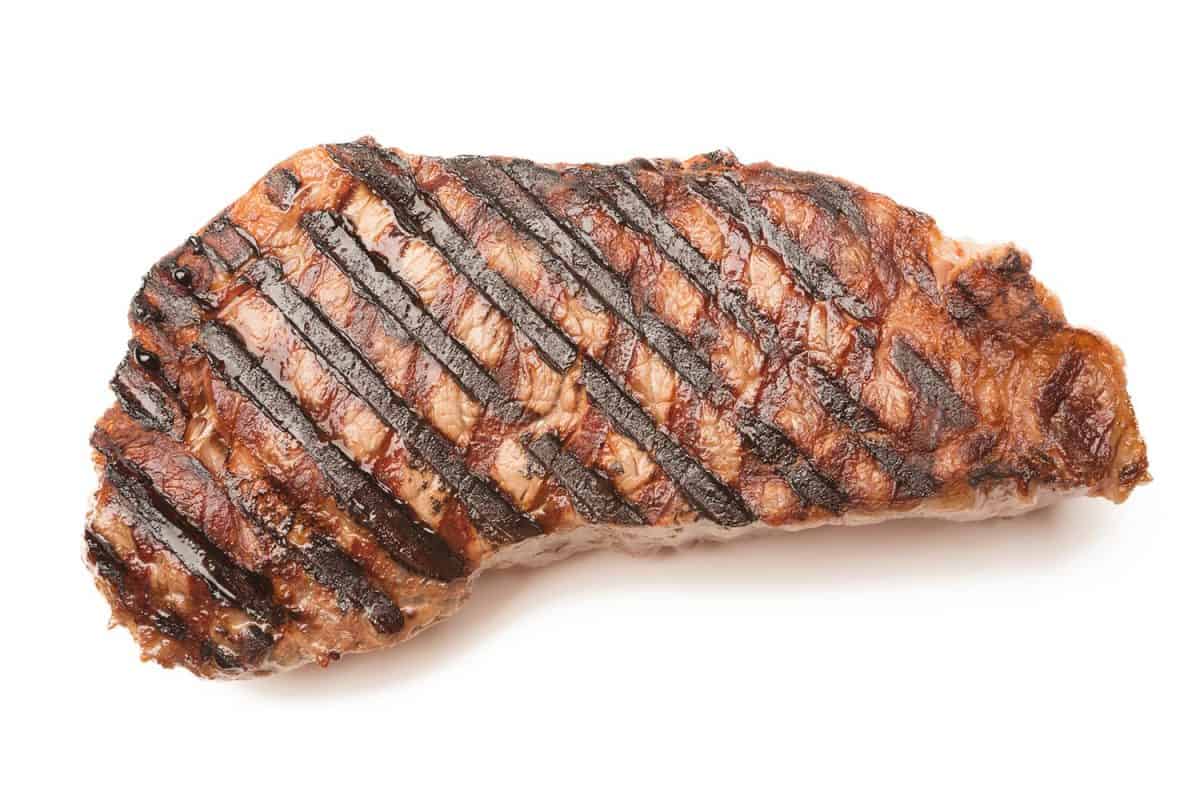
How long do you sear a steak on the grill?
Two to three minutes per side is the recommended time to sear the outside of your steak.
Thicker steaks—an inch or more in thickness—should be moved to an area of lower heat after searing to continue cooking steak to the desired state.
Remember it is always better to undercook a steak than it is to ruin your meat by overcooking.
Touch your meat
By touching or poking your meat with your fingers, you will quickly learn the consistency of steak when cooked to your preferred state of doneness. Here is a gauge:
- Meat is squishy when raw.
- Rare meat is soft but not as squishy as raw meat.
- Medium-rare meat offers some slight resistance to poking.
- Medium meat will spring back from being poked.
- Well done and overdone meat will feel firm to the touch.

Monitor time and temperature
Never leave your steak on the grill while you walk away. Monitoring the time for searing and the temperature of your meat while cooking can ensure optimal results.
Rare steaks should be cooked to an internal temperature of about 120 to 125 degrees Farenheight. Add another 5 to 10 degrees for medium-rare and another 5 degrees for a medium steak.
Resting your steak
Taking your steak off of the grill is not the last part of cooking. The meat will continue to cook about another 5 degrees once removed from direct heat.
Because of this, be prepared to remove your steak from the grill when it is about 5 degrees away from the temperature that you are trying to achieve.
Rest your steak under a foil tent for 30% to 40% of the total it cooked.
Five or 10 minutes is usually a good rule of thumb for meat resting time, ensuring proper redistribution of juices throughout your meat for a juicy, flavorful steak.
Avoid cutting into your steak until the resting period is complete to prevent moisture loss for juicy goodness.
Do you close the grill when cooking steak?
Closing the grill lid ensures that the temperature remains constant inside of the grill. Closing the grill when cooking steak will allow heat to be distributed evenly.
With this being said, you should cook thinner cuts of meat with the grill open to keep from burning your steak. Thicker cuts of steak should be cooked with the grill closed.
Should steaks be grilled over direct or indirect heat?
Steaks should always be seared over direct heat. Direct heat will ensure the caramelization of the outer layer of meat for a tasty, crispy crust.
Thicker steaks can be placed over indirect heat to continue cooking to their desired doneness.
How many times should you flip a steak on the grill?
Most experts agree that you should only flip a steak on the grill once. Poking into your steak with a fork repeatedly to flip it can cause moisture to leak from your steak.
If you are having trouble pulling the steak from the grill grates, it is not ready to be flipped yet. When the steak has been properly seared, it will pull itself away from the grates.
Final thoughts
A perfectly cooked steak is the ultimate grill food. Every cook has their own way of ensuring the perfect outcome. This makes it hard to distinguish myths from the truth when it comes to grilling.
Whether you like your steak rare or well done, we hope that this article has given you some helpful tips to cook your steak just the way you like.
Before you go, here are some other articles that may be of interest to you:
What Oil Is Best For Grilling Steak?
Should You Cover Steak When Pan Frying It?
Should You Always Marinate Steak? [Inc. 11 Awesome Steak Marinade Ideas]
How did your steak turn out? Let us know in the comments!


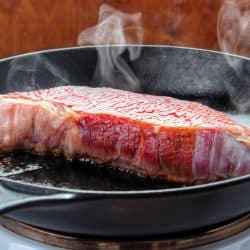
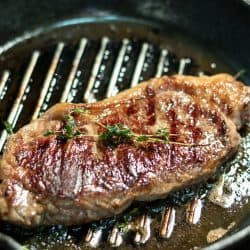
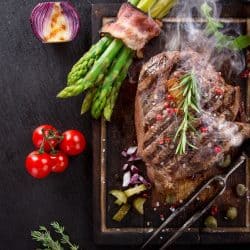
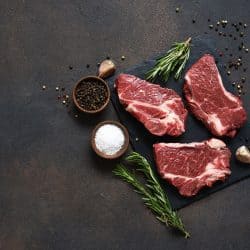
![A cook seasoning raw fillet mignon steaks, How Long Do You Rest Steak? [And Does It Keep Cooking When Resting?]](https://kitchenseer.com/wp-content/uploads/2021/04/A-cook-seasoning-raw-fillet-mignon-steaks-250x250.jpg)